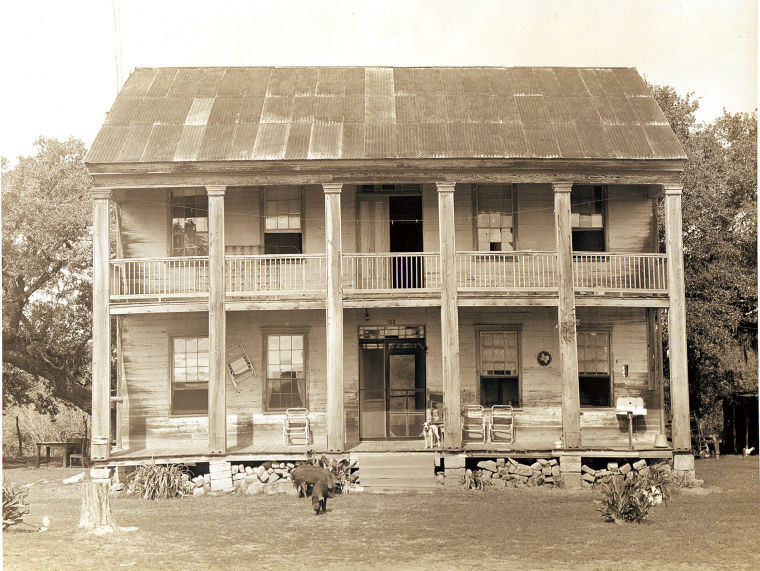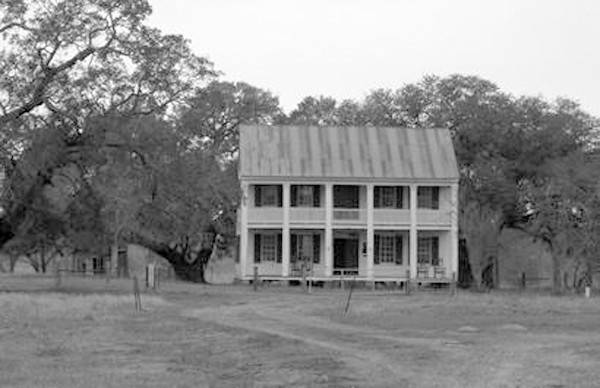Dillworth alum recalls rural life on family farm
Editor’s note: This is the second half of our Neighbors feature on Gonzales education in the post-World War II years. To reread part 1, click here.
Many times I accompanied Jimmy home on his bus route, staying overnight at his family’s chicken farm near the Cost community. Jimmy’s father managed the raising of several thousand “fryers” at one time. The baby chicks were delivered in cardboard boxes, and in a very few weeks, after spending their short lives eating 24 hours a day in a lighted barn, they were caught, stuffed in crates, and trucked to very foul-smelling slaughter houses in Gonzales and San Antonio. Each chicken house included a radio which was turned up as loud as possible so that the continuous noise covered-up summer thunderstorm noise that would otherwise scare the chickens into piling-up and smothering themselves.
On many days for lunch, Jimmy and I walked the six blocks from school to downtown Gonzales for a bowl of Lena’s Court House Café chili. A large bowl went for a dollar, including all of the saltine crackers you could eat. Sometimes Winson Hester joined us, but he liked the Gonzales Market barbecued brisket and sausage better.
A B-29, climbing out from San Antonio’s Randolph Field, crashed and burned in a cornfield not far from where Jimmy lived. The crashing plane sent up a large plume of smoke that was visible 20 miles away. Jimmy’s dad retrieved a smashed and charred instrument from the crash site. The flight crew parachuted safely.
Earl’s ride
In the fall of 1953, my best friend Earl Gerloff was the 15-year-old owner of a 1939 Chevy. No more hitchhiking. That car was our ticket to ride. We journeyed to Corpus Christi to see James Minear (his family had moved there over the summer). We toured the Houston amusement park, riding the tall wooden roller coaster. After staying the night in a Houston motel, we explored the Galveston beaches. We went to a San Antonio country western music concert headlined by Jimmy Heap. We haunted all of the Saturday night dance halls around Shiner, Yokum, and Luling.
Catering to the mostly Czechoslovakian and German population, the dance halls around Shiner featured “Oompah” polka bands. But that was changing. At Shiner’s Sunken Garden I heard my first Rhythm & Blues band. Among other less memorable tunes they played and sang “Shake, Rattle, and Roll.”
The dance halls couldn’t legally sell beer after Saturday midnight, so by one o’clock, everything closed down. So, with nothing better to do, Earl and I would stay up and meet the Sunday newspaper trucks at the corner of St. George and St. Joseph at 3 a.m. in Gonzales.
We rolled or folded Austin American, Houston Chronicle, and the San Antonio Express papers and waited for Mrs. Boring (that was her name really) to arrive in her 1940 Ford sedan.
With all the papers loaded in the Ford, she drove while Earl and I stood on the running board throwing whatever paper at whatever residence Mrs. Boring called out.
In the winter it was cold, and worse, raining. For our work we received $3 and when Michelson’s Café opened at seven, we would have bacon, eggs, and delicious pancakes. We slept all day Sunday at Earl’s house. Late Sunday afternoon Earl would take me home on his way to pick up his latest “behind Shiner” girlfriend.
Over the summer a traveling roller rink came through Gonzales, Yokum, Hallettsville, and most other small towns. A large tent was erected over a temporary hardwood floor in a vacant lot. Shoe skates were available for rent. After a two-week run, the tent and floor were moved to the next town. Roller skating was a new adventure for me, Earl, and Ray Hancock—we followed the circuit, finding a new girlfriend in every city.
Two miles south of Gonzales, beside the famous U.S. Highway 183 to Refugio (and north to Presho S. Dakota), Lynn Smith opened a drive-in movie theater in what had been a cow pasture. Drive-in movie theaters were a new and welcomed attraction, especially for teenagers. Mr. Smith and his son also operated the Crystal Theater, and by 1950-51 the utmost modern Lynn Theater was opened with great fanfare.
1953-54 Drought
It was exceptionally hot, all the cattle watering tanks dried up. When the windmill failed to supply enough water for the cattle Tom borrowed a “donkey engine” from Alton Kiefer to pump the well. 1954 would be our last year on the 183-acre Dilworth farm. Only one bale of cotton was gathered. Our total income for the year—cotton, calves, and hired out labor—couldn’t have been more than $1,000. A Central Texas dry land cotton farm could not compete with California’s Central Valley irrigated conglomerate, highly mechanized farms.
Tom knew mules, he was a mule-whisperer. Mechanical devices, such as tractors, were not within his expertise. I tried to get him to look at tractors, to drive one, but he wouldn’t. For some time my older brother Streeter out in California had been an outspoken advocate for our moving to California. In his last visit he talked about how we couldn’t make a living on the Dilworth farm and how California offered many opportunities for a better life. The decision to leave the Dilworth farm had been made—records reveal the Dilworth farm was sold to J. E. (Pete) Lawley on Dec. 7, 1954. Where to go was the only question. Mama wanted to move to California. Tom was skeptical but he finally agreed to go look.
In early December, in preparation for our trip to California, Tom had Virgil Gerloff, Earl’s father, and an Allen Chevrolet auto mechanic, overhaul the ’47 Plymouth’s engine. Before dawn on a mid-December day, I drove the Plymouth out the Dilworth road to U.S Highway 90A and turned right, headed west for California. At Seguin we boarded U.S. Highway 90 that took us to Van Horn. Then El Paso, Deming NM, Tucson Ariz., and Palm Springs, Calif.
Barely 16, with a fresh Texas driver’s license, I was in charge of driving and navigating the 1,600 miles from Gonzales to Fullerton, Calif. Neither Tom nor Mama had traveled outside of Texas. Tom had been “out on the plains” or “the Panhandle” (Abilene, Lubbock, Odessa) picking cotton during the Depression. Mama had moved up and down the Southern Pacific Railroad, from El Paso, in the west, to Louisiana in the east (Grandpa Wright was a Southern Pacific Section foreman).
After two and a half days of nothing but desert, we drove into Riverside, Calif., which looked just like the postcards: palm trees with mountains in the background. What a relief after thinking all of California might look like El Centro’s Algodones blow-sand. Another 25 miles and we pulled into a driveway at 1472 West Woodcrest, Fullerton, Calif. We spent Christmas with Streeter, Pat, and daughter Laurel, returning to Gonzales before the year’s end.
Moving to California
I took my last school bus ride with Mr. Shanklin in late January 1955. Over the next few days, with the exception of basic household necessities, everything on the Dilworth farm was sold, given away, or abandoned. The Brahma bull, his cows and calves, as well as the mules were loaded on a truck for the Gonzales Livestock Auction. I cried as my horse Sparky fought his loading, somehow he knew things would never be the same.
The mule farming harness and implements were left where they lay. There were no buyers because there were no mule farmers left. Everyone except Tom had made the conversion to mechanized farming by now.
For the move to California, Tom traded the ’47 Plymouth for a pea green 1950 Ford, flathead six cylinder, floor-shift, half-ton pickup truck. It had a custom built steel tubing cage installed in the pickup bed for hauling livestock—perfect for containing furniture and bedding.
At dawn, on a chilly February morning, good friend and neighbor Alton Kiefer helped us load Mama’s electric stove, Frigidaire, and Maytag wringer washer on the pickup and most of the other household wares in a U-Haul trailer. With Mr. Kiefer’s help, the U-Haul trailer had been rented in San Antonio the day before.
Tom, Mama, and I squeezed into the pickup cab. I drove out the front gate and never looked back. Late in the afternoon on the third day’s travel, we were unloading in Fullerton, Calif. Remarkably, I had driven the severely under-powered, overloaded pickup and trailer over 1,600 miles of two-lane roads without accident or breakdown.
Epilogue
I toured Gonzales County and Shiner in January 2012. The Dilworth School burned several years ago and is now a pile of rubble. Simerski’s cotton gin closed in the early ’60s. The gin house is now empty with the exception of the huge three-cylinder Tipps diesel engine (was it too big to move?). A few abandoned houses are left around the area but the house I was born in was torn down many years ago. The concrete steps to the front porch are still there however.
Alton Kiefer is the last man standing in Dilworth. Billy Chennault lives on his home place west of Peach Creek. T. J. Reid still lives on the gravel road where he boarded Mr. Shanklin’s bus. From cotton farming, to chicken farming, and now its cattle ranching.
I wanted to drive the old bus route through the “Abercrombie” Ranch but reading the very large “No Trespassing” signs killed the idea.
Comments










